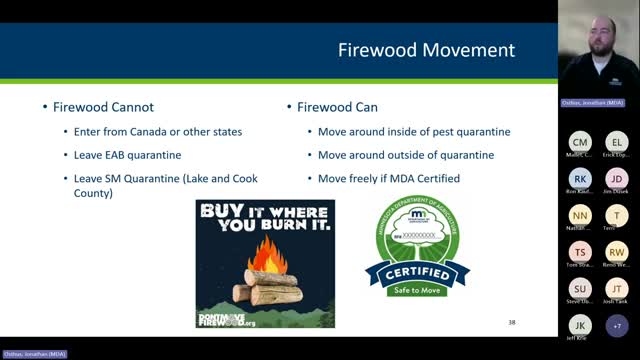Emerald Ash Borer Management Strategies Discussed at Community Forestry Meeting
January 25, 2024 | Agriculture, Department of , Agencies, Boards, & Commissions, Executive, Minnesota

This article was created by AI summarizing key points discussed. AI makes mistakes, so for full details and context, please refer to the video of the full meeting. Please report any errors so we can fix them. Report an error »

Residents of Cass, Isanti, and Kanabec Counties are urged to take proactive measures against the invasive Emerald Ash Borer (EAB) following a recent informational meeting hosted by the Minnesota Department of Agriculture. The meeting emphasized the importance of managing ash trees to prevent the spread of this destructive pest, which poses a significant threat to local forests.
One of the key points discussed was the critical need for communities to develop management plans that include an inventory of ash trees. This inventory will help identify which trees are at risk and allow for timely interventions. Participants were encouraged to consider both tree removals and insecticide treatments as effective strategies for managing EAB infestations.
The meeting highlighted the importance of not moving firewood long distances, as this can inadvertently spread EAB. Certified firewood, which has undergone heat treatment to eliminate pests, is recommended for use in state parks and other areas. Residents were reminded that just because a tree appears healthy on the outside does not mean it is free from infestation; the EAB larvae can be hidden beneath the bark.
Management practices were also discussed, with experts advising against working on ash trees during the summer months when EAB is most active. Instead, tree removals should ideally occur in the fall or winter when the beetles are dormant. If removal is necessary during the summer, it is crucial to minimize the risk of spreading the pest by leaving wood on-site or chipping it before transport.
Insecticide treatments were presented as a viable option for protecting ash trees, especially those that are healthy and have not yet shown significant signs of infestation. The effectiveness of these treatments depends on proper application and the health of the tree, with a general guideline suggesting that trees with less than 30% canopy decline are good candidates for treatment.
Communities are encouraged to explore grant opportunities through the Minnesota Department of Natural Resources to support their ash tree management efforts. As the threat of EAB continues to grow, proactive measures and community collaboration will be essential in preserving Minnesota's ash trees and maintaining the health of local ecosystems.
One of the key points discussed was the critical need for communities to develop management plans that include an inventory of ash trees. This inventory will help identify which trees are at risk and allow for timely interventions. Participants were encouraged to consider both tree removals and insecticide treatments as effective strategies for managing EAB infestations.
The meeting highlighted the importance of not moving firewood long distances, as this can inadvertently spread EAB. Certified firewood, which has undergone heat treatment to eliminate pests, is recommended for use in state parks and other areas. Residents were reminded that just because a tree appears healthy on the outside does not mean it is free from infestation; the EAB larvae can be hidden beneath the bark.
Management practices were also discussed, with experts advising against working on ash trees during the summer months when EAB is most active. Instead, tree removals should ideally occur in the fall or winter when the beetles are dormant. If removal is necessary during the summer, it is crucial to minimize the risk of spreading the pest by leaving wood on-site or chipping it before transport.
Insecticide treatments were presented as a viable option for protecting ash trees, especially those that are healthy and have not yet shown significant signs of infestation. The effectiveness of these treatments depends on proper application and the health of the tree, with a general guideline suggesting that trees with less than 30% canopy decline are good candidates for treatment.
Communities are encouraged to explore grant opportunities through the Minnesota Department of Natural Resources to support their ash tree management efforts. As the threat of EAB continues to grow, proactive measures and community collaboration will be essential in preserving Minnesota's ash trees and maintaining the health of local ecosystems.
View full meeting
This article is based on a recent meeting—watch the full video and explore the complete transcript for deeper insights into the discussion.
View full meeting
